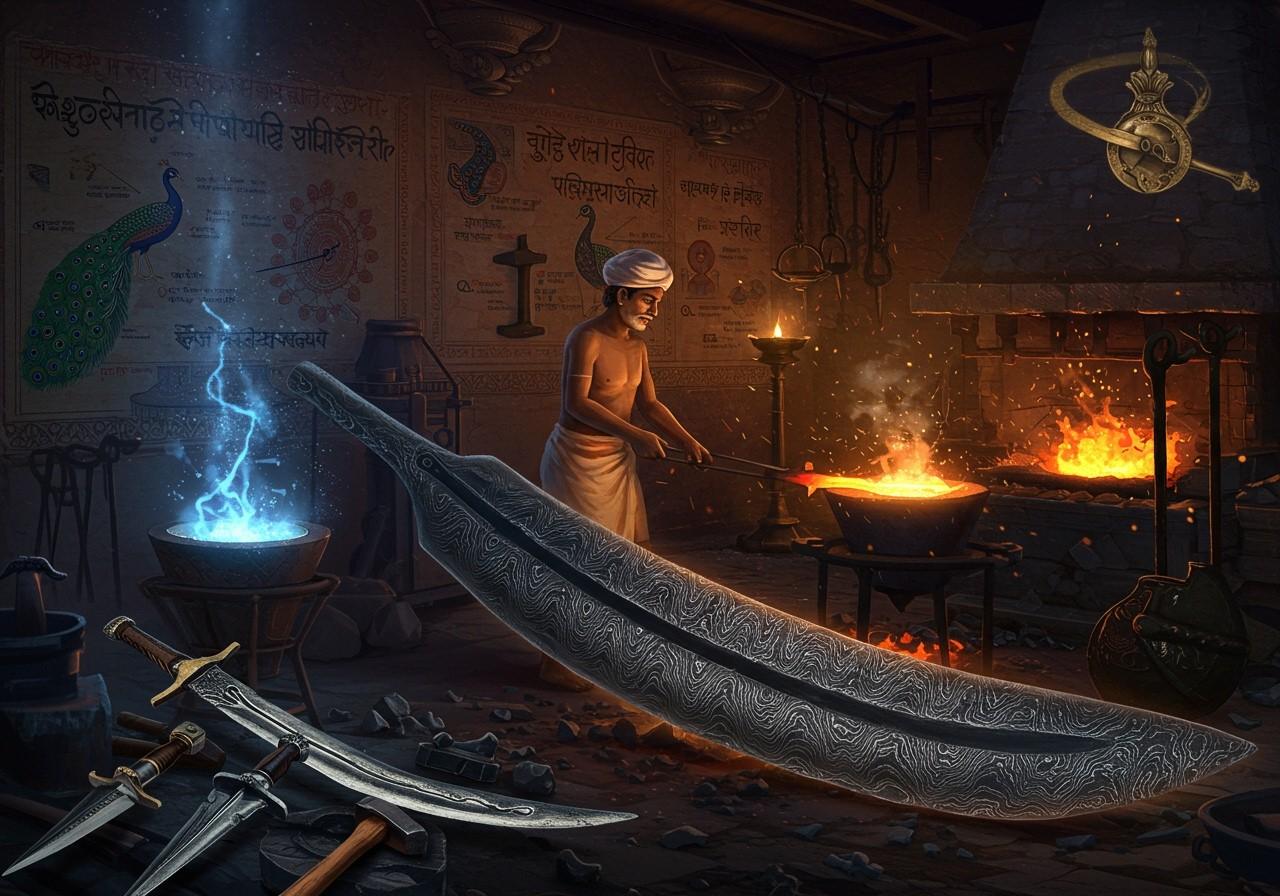
Wootz steel, a crucible steel renowned for its mesmerizing banding patterns and high carbon content, holds a significant place in India’s rich metallurgical history. Formed by sheets of microscopic carbides within a tempered martensite or pearlite matrix, this ancient steel, often referred to as Damascus steel, dates back to the 6th century BCE. Its exceptional hardness and sharpness captivated ancient civilizations and continue to intrigue modern metallurgists. Let’s delve into the composition, characteristics, historical significance, and modern applications of this remarkable material.
A Journey Through Time: The History of Wootz Steel
Originating in Southern India, specifically the Tamilakam region, Wootz steel production flourished under the expertise of ancient Indian blacksmiths. These skilled artisans developed and refined the crucible technique, enabling precise control over the alloy’s composition. This innovative approach resulted in a steel of exceptional quality, prized for its durability and keen edge. Wootz steel became a sought-after commodity, traded extensively across the globe, influencing sword-making traditions in the Middle East and even reaching the hands of warriors in Alexander the Great’s army. However, its prominence waned during the colonial era due to shifts in trade dynamics and technological advancements.
Deconstructing Wootz: Composition and Characteristics
The remarkable properties of Wootz steel stem from its unique composition. With a high carbon content ranging from 1-2%, along with trace elements like vanadium, chromium, and molybdenum (naturally present in the ore), Wootz steel possesses exceptional hardness and edge retention. Its signature “watered silk” or “wood grain” pattern, a result of the unique banding formed during the forging process, distinguishes genuine Wootz steel. It’s important to note that while high carbon content contributes to its hardness, impurities like phosphorus also decrease toughness and malleability. Therefore, diffuse annealing at high temperatures is crucial before forging to improve workability. Microstructures such as cementite, ferrite, and pearlite further contribute to its distinct characteristics, offering a balance of flexibility and toughness.
Wootz Steel in Action: Applications Then and Now
Historically, the exceptional strength and sharpness of Wootz steel made it the preferred choice for crafting weapons, including swords, daggers, and various bladed tools. Its resilience and ability to maintain a sharp edge made it invaluable on the battlefield. Today, Wootz steel continues to be cherished, finding its way into high-end cutlery, surgical instruments where precision and durability are paramount, and even luxury timepieces. Modern metallurgists study Wootz steel, drawing inspiration from ancient techniques to enhance contemporary steel-making processes. Furthermore, it plays a role in artistic creations and cultural heritage preservation, serving as a tangible link to India’s rich metallurgical past.
The Resurgence of Wootz: Renewed Interest and Preservation
The 20th century witnessed a revival of interest in Wootz steel, spearheaded by metallurgists and historians eager to unravel the secrets of this ancient material. Scientific studies and meticulous experiments aim to replicate the traditional production methods, while modern technology provides deeper insights into its complex composition and properties. Efforts are underway to preserve the traditional Wootz steel-making techniques in India, ensuring that this invaluable knowledge is passed on to future generations. Wootz steel remains a symbol of national pride, embodying the ingenuity and craftsmanship of ancient Indian metallurgy.
Connecting with Tradition: Explore Ritual Metal Items at Poojn.in
While Poojn.in doesn’t offer Wootz steel products directly, we invite you to explore our extensive collection of authentic ritual items that reflect India’s rich metallurgical heritage. Discover handcrafted pieces that connect you to the spirit of ancient traditions:
- Pure copper vessels: Ideal for storing sacred water, these vessels embody purity and tradition. Crafted with meticulous detail, they serve as a beautiful and functional addition to your rituals.
- Bronze bells: Enhance your temple worship with the resonant tones of our handcrafted bronze bells. Each bell carries the essence of ancient craftsmanship, adding a sacred dimension to your prayers.
- Brass items for daily puja: Elevate your daily puja rituals with our exquisite brass items. From intricately designed diyas (lamps) to other ceremonial objects, our collection offers a wide range of choices to suit your needs.
- Traditional metal lamps (diyas): Illuminate your sacred space with the warm glow of our traditional metal diyas. Available in various designs and sizes, these lamps symbolize the dispelling of darkness and the invitation of positive energy.
At Poojn.in, we are committed to providing high-quality products that honor the traditions of Indian craftsmanship. Each item is accompanied by detailed information regarding material composition, quality certifications, care instructions, and its traditional significance. We offer pan-India delivery and secure online payment options, ensuring a seamless and convenient shopping experience. Our dedicated customer support team is always available to assist you in selecting the perfect items for your spiritual needs.
Conclusion: The Enduring Legacy of Wootz Steel
Wootz steel stands as a testament to the ingenuity and skill of ancient Indian metallurgists. Its unique composition, exceptional properties, and diverse applications have left an indelible mark on history. The rediscovery and continued study of Wootz steel not only preserve a vital part of India’s cultural heritage but also inspire advancements in modern materials science. As we continue to explore the mysteries of this remarkable material, we honor the legacy of our ancestors and celebrate the enduring brilliance of traditional Indian craftsmanship.


